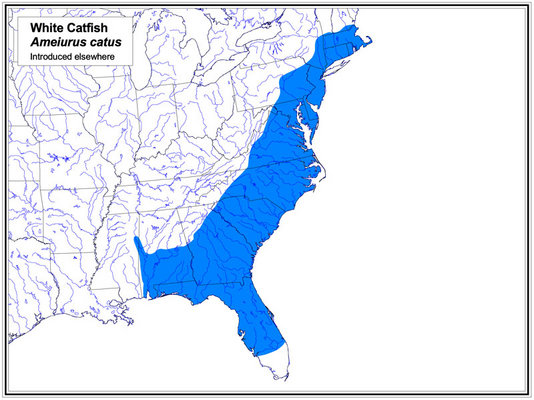Ameiurus catus
White Catfish
Larry PageIdentification
The White Catfish is normally gray to blue-black above - without a dark blotch at the dorsal fin base, white to light yellow below, and has a dusky black adipose fin and white or yellow chin barbels. Very large individuals are blue-black above and white or blue below. The White Catfish has a moderately forked caudal fin, and an anal fin with a short base, a rounded outline, and 22-25 rays. There are 11-15 fairly large sawlike teeth on the rear edge of the pectoral fin spine, and 18-21 rakers on the 1st gill arch. To 24 1/4 in. (62 cm).
Range
The species occurs in Atlantic and Gulf Slope drainages from the lower Hudson River in New York, to the Pascagoula River in Mississippi and south in peninsular Florida to the Peace River drainage. These species is common within its native range and has been introduced widely outside its native range.


Native distribution of Ameiurus catus. © Larry Page
Habitat
The White Catfish is found in sluggish, mud-bottomed pools and in open channels and backwaters of small to large rivers. It also is found in lakes and impoundments.
Similar Species
The Channel Catfish, Ictalurus punctatus, Headwater Catfish, I. lupus, Yaqui Catfish, I. pricei, and Blue Catfish, I. furcatus, have a more deeply forked caudal fin. The Blue Catfish has a straight-edged anal fin, and most Channel, Headwater and Yaqui Catfishes have dark spots on a light body.
About This Page
Larry Page

Florida Museum of Natural History, Gainesville, Florida, USA
Correspondence regarding this page should be directed to Griffin Sheehy at and Larry Page at
Page copyright © 2007 Larry Page
All Rights Reserved.
- First online 23 May 2007
- Content changed 23 May 2007
Citing this page:
Page, Larry. 2007. Ameiurus catus . White Catfish. Version 23 May 2007 (under construction). http://tolweb.org/Ameiurus_catus/69833/2007.05.23 in The Tree of Life Web Project, http://tolweb.org/








 Go to quick links
Go to quick search
Go to navigation for this section of the ToL site
Go to detailed links for the ToL site
Go to quick links
Go to quick search
Go to navigation for this section of the ToL site
Go to detailed links for the ToL site